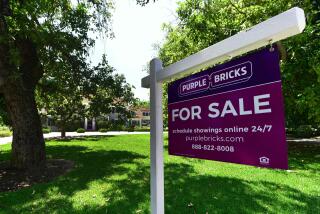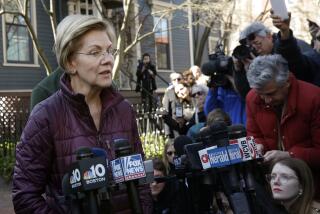YOUR TAXES : PART SIX: PROFILE : Upper-middle-class property owners : Reducing mortgage and buying tax-exempt securities is their soundest strategy
Tim and Judy Haidinger never embraced the exotic tax shelters that other upper-middle-class Americans used to shield their incomes under the old tax law, but that isn’t making the impact of the Tax Reform Act of 1986 any less painful. A chief target of the landmark legislation was the affluent but sheltered taxpayer and, with the Haidingers, it hit a bull’s-eye.
“The tax bill was a real blow to me,” said Tim Haidinger, 45, president of New West Ventures Inc., a venture capital management fund with offices in Newport Beach and La Jolla.
For the last six years, the income of Haidinger and his homemaker wife has been substantially sheltered by a very large operating loss dating from 1980. In 1986, the Haidingers exhausted the deductions generated by that loss. Combined with the effects of the new tax law, that means the couple will begin paying more taxes in 1987 than they have ever paid in their lives. And unless they modify their financial portfolio, their tax payments will escalate steeply as provisions of the new tax law are phased in over the next four years.
While the Haidingers’ profile is the unique reflection of their own career directions and investment strategies, it demonstrates how the new tax law can affect families who planned their peak earning years around a set of rules that no longer apply.
“Their circumstances are individual, but their issues are widespread,” said Jacqueline Patterson, a tax accountant in the Beverly Hills office of Arthur Young & Co., a Big Eight accounting firm.
The Haidingers achieved the dubious honor of being in the tax bill’s target population chiefly through shrewd real estate investments begun in the early 1970s, when Tim was working as a management consultant at a major public accounting firm. His earned income at the time was about $35,000 a year--enough money to live well and invest at the same time.
“I don’t like passive things that I don’t have any control over,” said Tim, an engineering graduate from the University of Notre Dame who went on to earn an MBA from Stanford University. “Real estate was doing well, and I was comfortable with it.”
The Haidingers began with a residential fourplex, waited for it to appreciate and then traded it for a 16-unit apartment building. Through the 1970s, they repeated the process over and over until they were owners of a small shopping center in Westminster. Through most of the transactions, depreciation, interest and operating expenses largely sheltered their rental income while the value of their investments grew.
The shopping center proved to be the Haidingers’ investment Waterloo. Troubled by vacancies that depressed rental income, and financed with a loan pegged several points above the prime rate when that benchmark was at record highs, the center generated staggering operating losses.
At one point, Tim said, he was subsidizing the center with more than $50,000 a month. These operating losses became the Haidingers’ chief income tax shelter, which they used to offset their personal income in six subsequent tax years.
By 1986, when they finally exhausted those deductions, their income came chiefly from two sources: a salary in the low six figures that Haidinger draws from his venture capital business and interest on savings.
Their financial profile is relatively straightforward. Continuing their strategy of trading up to new properties, the Haidingers in 1986 exchanged their shopping center for an industrial complex in Chula Vista. They have no significant personal stock holdings or other sources of income that might be affected by the tax law, and Tim has created no income-deferral programs or other unusual compensation schemes. The couple’s single major debt is the mortgage on their spacious San Diego home. Payments consume about half of his adjusted gross income. They sold a second home in 1986 because it was expensive to maintain and was depreciating in value. They don’t plan to acquire another.
One of the biggest expenses currently facing the Haidingers is the education of their two daughters, ages 15 and 17. Tim estimates that it will cost $40,000 to $80,000 each to send the girls to college, depending on whether they attend public or private schools.
Based on a computer analysis of the Haidinger family’s balance sheet and income tax records, Arthur Young & Co. tax partner Robert E. Billings and accountant Patterson identified the industrial park and the savings currently in taxable bank deposits as the primary vehicles that the couple could use to reduce their taxes.
Before the Tax Reform Act, taxpayers could use so-called passive business losses from investments such as rentals to shelter their personal income without limit. But beginning this year, that practice is being phased out. In 1987, taxpayers may use only 65% of net passive losses as a deduction against “active” income. That percentage drops each year until the deduction is eliminated altogether in 1991.
So the first place that the tax analysts looked to soften the blow was the passive loss created by the Haidingers’ industrial complex. The property generates substantial losses because it was acquired when investors could depreciate their property over an accelerated 19-year schedule, instead of the current 31 1/2 years, a factor that nearly triples their depreciation deduction. “What we want to do is reduce the loss, since the Haidingers can’t benefit from it,” Patterson said.
To do that, Billings recommends that the couple cut their interest expense on the property by taking money out of savings and paying down the mortgage, a strategy that any taxpayer with a mortgaged passive investment and some liquid assets might consider pursuing.
Then, to reduce the Haidingers’ taxable income--from salary, interest or dividends--Patterson suggested that they invest the bulk of their remaining savings in tax-exempt government securities.
These maneuvers would not eliminate the Haidingers’ tax liability altogether, or even return it to pre-reform levels, the analysts found. But by containing their passive losses and putting a major source of active income into tax-free investments, the couple can reduce their tax liability by 90% in 1987 and by only somewhat less through 1989.
As for the impending college costs, Patterson noted that there is little time for the Haidingers to begin planning a means to pay for them. One possible avenue, she said, is employing the teen-agers in his business.
More to Read
Inside the business of entertainment
The Wide Shot brings you news, analysis and insights on everything from streaming wars to production — and what it all means for the future.
You may occasionally receive promotional content from the Los Angeles Times.










